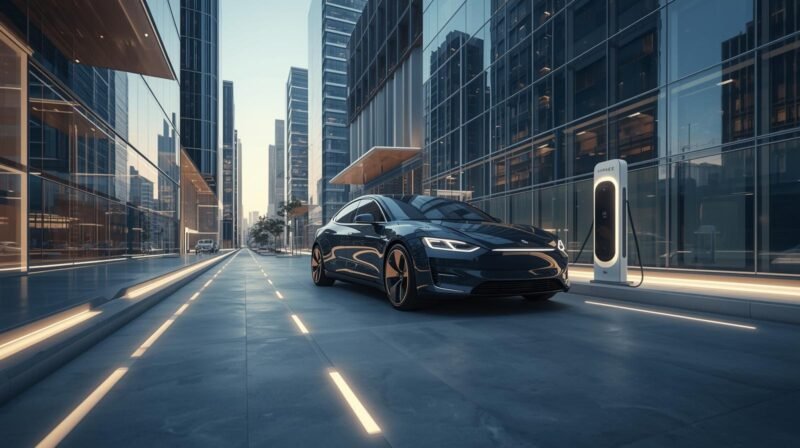The Rise of Electric Vehicles: Trends and Predictions
The electric vehicle (EV) market has experienced significant growth over the past decade, becoming a pivotal element of the broader auto industry landscape. According to recent statistics, global EV sales surged by over 100% from 2020 to 2021, and this trend has continued, with leading market analysts forecasting that by 2030, EVs will represent approximately 30% of total vehicle sales globally. Major players such as Tesla, Nissan, and new entrants like Rivian and Lucid Motors have enhanced competition, fostering innovation in battery technology and vehicle design. Furthermore, established automotive giants like Ford and General Motors have pledged substantial investments aimed at electrifying their fleets.
Emerging technologies are key drivers in this transition. Lithium-ion battery advancements, including increased energy density and faster charging capabilities, have made EVs more attractive to consumers. Moreover, innovations in solid-state batteries promise to revolutionize the market by offering even greater efficiencies and safety, potentially multiplying adoption rates. As charging infrastructure improves, with expanded charging networks and faster charging stations, consumer confidence is likely to rise.
Government policies also play a crucial role in the transition to electric vehicles. Enhanced incentives for EV purchases, alongside stricter emissions regulations, are encouraging both manufacturers and consumers to embrace electrification. Countries such as Norway and the Netherlands are leading the way, with aggressive targets for phasing out internal combustion engine vehicles. By 2030, these nations aim to achieve nearly complete electrification of new vehicle sales, influencing others to follow suit.
Consumer preferences are evolving; there is a growing awareness of environmental impact among potential car buyers, driving the demand for sustainable transport solutions. With a combination of market growth, technological advancements, governmental support, and shifting consumer attitudes, the future of electric vehicles appears promising, setting the stage for a new era in sustainable transport.
Innovative Technologies Shaping Sustainable Transport
Innovation plays a pivotal role in the ongoing transition to sustainable transport, particularly through advancements in electric vehicle technology. Central to these advancements are battery technologies, which are making electric cars increasingly efficient and affordable. Recent improvements in lithium-ion batteries have led to enhanced energy storage capacities, reduced charging times, and lower overall costs. These progressions are complemented by developments in next-generation batteries, such as solid-state and lithium-sulfur batteries, which promise even greater ranges and quicker recharges, thereby addressing some of the essential concerns of consumers considering electric vehicles.
Moreover, the expansion of charging infrastructure is critical to supporting the growing number of electric vehicles on the roads. Governments and private sectors are investing in widespread and accessible charging stations, making the adoption of electric cars more feasible. Innovative solutions, such as fast-charging networks and wireless charging capabilities, are emerging as significant drivers of this movement. Additionally, the integration of renewable energy sources into charging systems is enhancing the sustainability factor of electric vehicles, as more drivers can charge their cars using solar, wind, or other clean energy sources.
Beyond personal vehicles, the electrification of public transport is also gaining momentum. Electric buses represent a significant leap toward sustainable urban mobility, providing an environmentally friendly alternative to traditional diesel-powered buses. Cities around the world are increasingly adopting electric buses to reduce air pollution and greenhouse gas emissions. Additionally, comprehensive smart city planning is crucial in promoting sustainable transport. Implementing intelligent traffic management systems and enhancing public transport connectivity fosters a more extensive use of electric transportation resources, encouraging residents to opt for sustainable options. As these innovations intersect, they form a holistic ecosystem that supports the broader goal of sustainable mobility.
Challenges and Solutions in the Transition to Electric Mobility
The transition to electric mobility, while promising, is not without its challenges. One of the most pressing issues is the inadequate charging infrastructure that can support a growing fleet of electric vehicles (EVs). The current network of charging stations is often insufficient, leading to range anxiety among potential electric car users. This anxiety poses a significant barrier to the widespread adoption of electric transportation, as potential buyers may hesitate due to concerns about finding suitable charging locations during their travels.
Another notable challenge lies in the battery supply chains, which are critical for the production of electric vehicles. Raw materials such as lithium, cobalt, and nickel are necessary for battery manufacturing. As demand for electric cars increases, so does the importance of establishing sustainable and ethical sourcing practices for these materials. Inconsistencies in policy, which can vary substantially by region, further complicate efforts to achieve a streamlined and equitable transition to electric mobility.
Cost barriers also play a significant role in the slow adoption of electric vehicles. Although the prices of electric cars have been gradually decreasing, the initial cost still tends to be higher than that of conventional vehicles. This can discourage consumers from making the transition to electric models. Solutions to address these challenges involve collaborative efforts between governments, industry players, and communities.
Public-private partnerships can enhance the development of charging infrastructure, enabling a more extensive network that promotes confidence in electric vehicle usage. Additionally, government incentives, such as tax credits or rebates, can help offset the initial costs associated with purchasing electric vehicles. Community-based initiatives, including awareness campaigns and investment in local charging stations, can also play a vital role in fostering an environment that supports sustainable transport. Implementing these solutions is essential for navigating the challenges of transitioning to electric mobility.
The Environmental Impact: Benefits and Considerations
The transition from traditional vehicles to electric cars presents several significant environmental benefits, while also raising critical considerations regarding sustainability. Electric vehicles (EVs) are often heralded for their potential to reduce greenhouse gas emissions, particularly in urban areas where air quality is a major concern. By replacing gasoline and diesel engines with electric powertrains, EVs contribute to the reduction of harmful pollutants, thus improving urban air quality and public health.
However, to comprehensively understand the environmental impact of electric cars, it is essential to evaluate the entire lifecycle emissions. This includes the carbon footprint associated with the production of electric vehicles, which can be substantially higher than that of internal combustion engine vehicles due to the materials used, particularly lithium for batteries. As the demand for electric cars rises, sustainably sourcing these materials becomes paramount. The extraction and processing of lithium, cobalt, and other materials can lead to significant environmental degradation if not managed wisely.
Another consideration is the disposal of batteries at the end of their life cycle. Currently, many batteries are not recycled effectively, leading to waste and potential environmental harm. Integrating circular economy principles within the automotive industry can facilitate the responsible management of electric vehicle batteries. This approach emphasizes minimizing waste through recycling and reusing materials, thus ensuring that electric cars contribute positively to our planet’s sustainability goals.
Ultimately, while electric vehicles hold great promise in reducing carbon emissions, a thorough examination of their environmental impact requires a focus on sustainable practices throughout their lifecycle. This includes sourcing materials ethically, ensuring effective recycling systems, and considering the broader implications of manufacturing processes in the goal of achieving a truly sustainable transport system.


